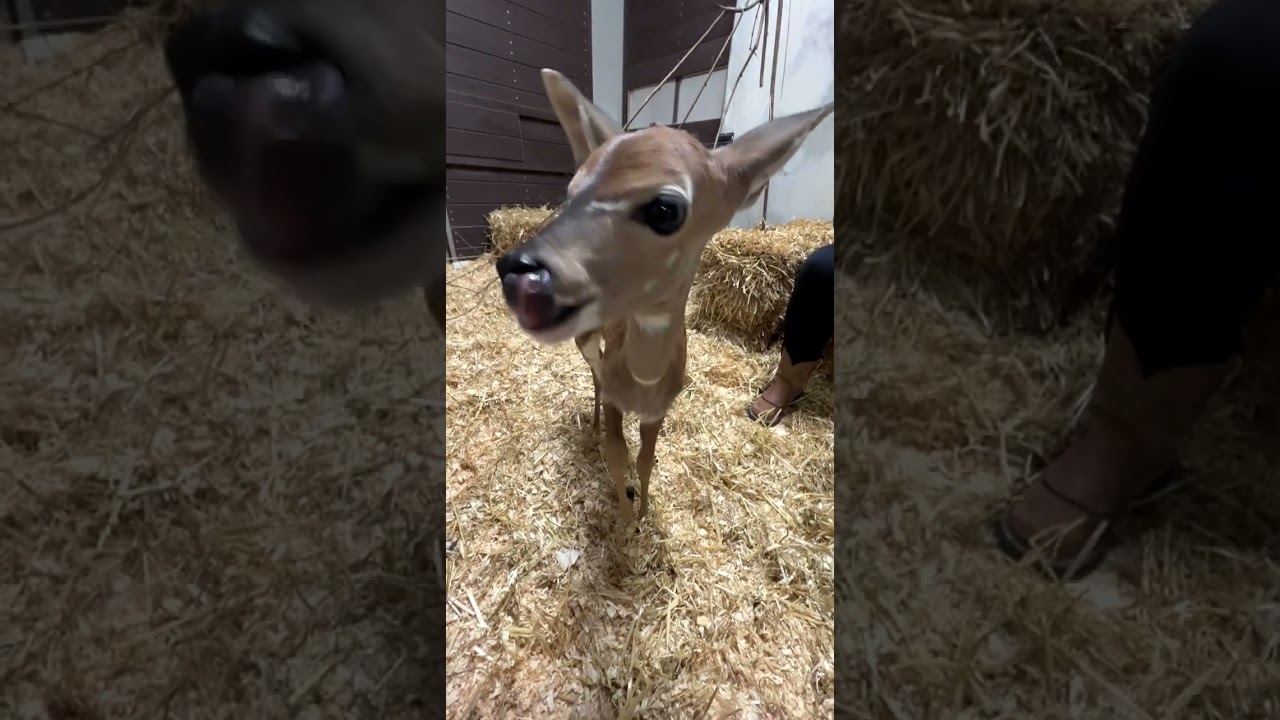– Experience the joy and curiosity surrounding the growth of a newborn kudu named Maisy at the Cincinnati Zoo.
– Explore the unique aspects of kudu biology and behavior, shedding light on these graceful antelopes.
– Understand the valuable role zoos, including the Cincinnati Zoo, play in wildlife conservation and education.
– Discover how organizations like Great American Insurance Group support wildlife and habitat conservation efforts.
– Dive into the impact of interactive digital content on public engagement and education in wildlife conservation.
Bringing the Wonders of the Wild into View: Kudu Maisy’s First Steps into Life
It’s a scene of tender growth, a testament to wildlife’s resilience – Maisy, a two-week-old kudu at the Cincinnati Zoo, captures viewers’ hearts with each step she takes. The Cincinnati Zoo, renowned for its longstanding commitment to conservation and wildlife care, reveals another life narrative through the lens of a sprightly young antelope.
Hailing from the savannas and woodlands of eastern and southern Africa, Kudus hold a ballet of grace within their long limbs. The Greater kudu, to which Maisy belongs, is an emblem of the wild’s elegance. Their spiral horns, present on males, can reach astounding lengths, often making them a site of admiration and wonder.
Watching Maisy prance about reveals insights into the subtleties of kudu behavior. These antelopes are lovely to look at and remarkably adapted to their habitat. From their keen sense of hearing, indicated by large radar-like ears, to their impressive jumping ability and deftly avoiding predators, their survival skills are nearly perfect.
It’s not just their physical prowess that interests me; their social structures are equally fascinating. Typically, female kudus, like Maisy, will remain in maternal groups, a tapestry of mothers, daughters, and sisters, while males lead a more solitary existence or form bachelor herds. Observing these dynamics at the zoo provides a glimpse into the complexities of their social world.
The zoo serves as a crucial bridge between human and animal realms, highlighting the need for conservation. Organizations such as Great American Insurance Group underscore this mission by supporting zoos in their endeavors to protect wildlife. Their sponsorship helps residents like Maisy thrive and serve as ambassadors for their wild counterparts.
But why does this matter? Why should a newborn kudu, even as charming as Maisy, warrant our attention? The answer lies in the delicate web of biodiversity. Each species, including the Greater Kudu, is pivotal in its ecosystem. Its grazing habits help shape the vegetation structure and signify a healthy, balanced environment. When we protect them, we uphold the integrity of nature itself.
The digital revolution has ushered in a new age of wildlife engagement. Platforms like YouTube and social media pages belonging to the Cincinnati Zoo allow us to witness animals like Maisy’s once-remote daily happenings. This innovation fosters a connection and empathy that might otherwise be difficult to cultivate from afar. It inspires people to learn, to care, and ultimately, to act.
Conservation efforts today are more interactive than ever. By donating to institutions like the Cincinnati Zoo, the public actively supports the habitats and lives of these extraordinary creatures. This level of involvement generates a community of wildlife champions united in the goal of a more sustainable and wildlife-inclusive future.
Digital mediums also grant us the privilege of continuous learning. As Maisy grows, so too does the collective understanding of kudu life. Each update, each shared video, allows onlookers to track her development, witness her milestones, and understand her species a little better.
The role of zoos in this grand narrative is multifaceted. Not only do they care for and maintain the health of animals like Maisy, but they also educate the public and prompt discussions about wildlife conservation. They are centers of research, learning, and hope for species that face threats in the wild, from habitat loss to poaching.
But it’s not just about the here and now. Zoos are considering participating in breeding programs that ensure genetic diversity and species longevity, like the kudu. They’re crafting a safety net, a repository of life that can be called upon should the unthinkable happen and populations in the wild diminish past the point of no return.
The story of Maisy, the fledgling kudu of the Cincinnati Zoo, is more than a narrative of cuteness. It’s a drumbeat of conservation, the interconnectedness of all living things, and the human capacity to support and uplift the natural world.
As we marvel at Maisy’s growth and antics, let’s not forget the underlying message – the importance of each species in the tapestry of life, no matter how large or small. Their survival and prosperity reflect our actions, choices, and willingness to stand as stewards of the planet.
With this in mind, let us enjoy Maisy’s snippets of joy and development. Let her be a beacon of the work yet to be done. Let her inspire us to learn, engage, and protect the wild we dearly cherish. After all, a world replete with the wonders of creatures like Maisy is a world that’s richer for us all.
*****
Source Description
Kudu Maisy is 2 Weeks Old. This great video is brought to you by Great American Insurance Group. #shorts
http://support.cincinnatizoo.org/donate
Subscribe: https://www.youtube.com/user/CincinnatiZooTube/featured
Facebook: https://www.facebook.com/cincinnatizoo/
Twitter: https://twitter.com/CincinnatiZoo
Instagram: https://www.instagram.com/cincinnatizoo/
Find out more at http://www.cincinnatizoo.org

